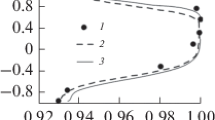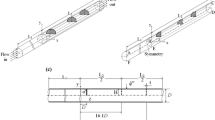Abstract
Turbulent flow in a mixed compression intake is investigated. The unsteady compressible Navier–Stokes equations are solved using a stabilized finite element method with 6-noded triangular element. The Spalart–Allmaras model is used for turbulence closure. For comparison, the laminar flow is studied as well. A bleed of 6 % is utilized to overcome the start-up problem of the intake. The effect of back pressure on the performance of the intake is studied via the total pressure recovery and distortion index. Total pressure recovery is relatively lower while distortion index is higher for turbulent flow compared to laminar flow. The critical back pressure ratio, for unstart of the intake, for turbulent flow is higher compared to laminar flow. The effect of bleed on the performance of the intake is studied.















Similar content being viewed by others
Abbreviations
- \(p_b/p_i\) :
-
Back pressure ratio
- \(\rho \) :
-
Density
- DI:
-
Distortion index, (\(p_{0max} - p_{0min})\)/\(\bar{p}_{0}\)
- \(\mu \) :
-
Dynamic viscosity
- \({\nu }\) :
-
Kinematic viscosity
- \(\tilde{\nu }\) :
-
Kinetic eddy viscosity
- M:
-
Mach number
- \(\dot{m}\) :
-
Mass flow rate
- Re:
-
Reynolds number
- p:
-
Static pressure
- \(\theta \) :
-
Static temperature
- TPR:
-
Total pressure recovery, \(\bar{p}_{0}\)/\(p_{0i}\)
- \(\mu _t\) :
-
Turbulent viscosity
- \(\infty \) :
-
Free-stream
- i:
-
Inflow
- cowl:
-
Lower cowl wall
- ramp:
-
Ramp wall
- t:
-
Throat
- 0:
-
Total/stagnation
- \(\sim \) :
-
Favre-mass averaging
- –:
-
Reynolds averaging
- \({''}\) :
-
Unsteady fluctuation
References
Hill, P.G., Peterson, C.R.: Mechanics and Thermodynamics of Propulsion, vol. 1. Addison-Wesley Publishing Co., Reading (1992)
Seddon, J., Goldsmith, E.L.: Intake Aerodynamics, vol. 2. Blackwell science, London (1999)
Oswatitsch, K.: Pressure Recovery in Missiles with Reaction Propulsion at High Supersonic Speeds. NACA TM-1140. National Advisory Committee for Aeronautics, Washington (1947)
Ferri, A., Nucci, R.: The Origin of Aerodynamic Instability of Supersonic Inlets at Subcritical Conditions. NACA RM-L50K30. National Advisory Committee for Aeronautics, Washington (1951)
Trimpi, R.: A Theory for Stability and Buzz Pulsation Amplitude in Ram Jets and an Experimental Investigation Inducing Scale Effects. NACA Report-1265. National Advisory Committee for Aeronautics, Washington (1953)
Dailey, C.L.: Supersonic diffuser instability. J. Aeronaut. Sci. 22, 733–749 (1955)
Fisher, S., Neale, M., Brooks, A.: On the Sub-Critical Stability of Variable Ramp Intakes at Mach Numbers Around 2. National Gas Turbine Establishment, ARC R. & M. no.3711 (1970)
Herrmann, D., Gülhan, A.: Experimental analyses of inlet characteristics of an airbreathing missile with boundary-layer bleed. J. Propuls. Power 23, 1–10 (2014).
Newsome, R.W.: Numerical simulation of near-critical and unsteady, subcritical inlet flow. AIAA J. 22(10), 1375–1379 (1984)
Shigematsu, J., Yamamoto, K., Shiraishi, K., Tanaka, A.: A numerical investigation of supersonic inlet using implicit TVD scheme. AIAA Paper 2135 (1990)
Lu, P.J., Jain, L.T.: Numerical investigation of inlet buzz flow. J. Propuls. Power 14(1), 90–100 (1998)
Trapier, S., Duveau, P., Deck, S.: Experimental study of supersonic inlet buzz. AIAA J. 44(10), 2354–2365 (2006)
Lee, H.J., Lee, B.J., Kim, S.D., Jeung, I.S.: Flow characteristics of small-sized supersonic inlets. J. Propuls. Power 27(2), 306–318 (2011)
Knight, D.D.: Improved calculation of high speed inlet flows. part II: results. AIAA J. 19(2), 172–179 (1981)
Knight, D.: Calculation of a Simulated 3-D High Speed Inlet Using the Navier–Stokes Equations. AIAA Paper (83-1165) (1983)
Chan, J.J., Liang, S.M.: Numerical investigation of supersonic mixed-compression inlet using an implicit upwind scheme. J. Propuls. Power 8(1), 158–167 (1992)
Anderson, W.E., Wong, N.D.: Experimental Investigation of a Large Scale, Two-Dimensional, Mixed-Compression Inlet System: Performance at Design Conditions, \({M}_{\infty }=3.0\). NASA TM X-2016 (1970)
Jain, M.K., Mittal, S.: Euler flow in a supersonic mixed-compression inlet. Int. J. Numer. Methods Fluids 50, 1405–1423 (2006)
Kotteda, V.M.K., Mittal, S.: Viscous flow in a mixed compression intake. Int. J. Numur. Methods Fluids 67, 1393–1417 (2011)
Vivek, P., Mittal, S.: Buzz instability in a mixed-compression air intake. J. Propuls. Power 25, 819–822 (2009)
Trapier, S., Deck, S., Duveau, P.: Delayed detached-eddy simulation and analysis of supersonic inlet buzz. AIAA J. 46(1), 118–131 (2008)
Hughes, T.J., Brooks, A.: A multidimensional upwind scheme with no crosswind diffusion. Finite Elem. Methods Convect. Domin. Flows AMD 34, 19–35 (1979)
Brooks, A.N., Hughes, T.J.R.: Streamline Upwind/Petrov–Galerkin formulations for convection dominated flows with particular emphasis on the incompressible Navier–Stokes equations. Comput. Methods Appl. Mech. Eng. 32, 199–259 (1982)
Tezduyar, T., Hughes, T.: Finite element formulations for convection dominated flows with particular emphasis on the compressible Euler equations. In: Proceedings of AIAA 21st Aerospace Sciences Meeting, AIAA Paper, vol. 83, p. 0125 (1983)
Le Beau, G.J., Tezduyar, T.E.: Finite element computation of compressible flows with the SUPG formulation. In: Dhaubhadel, M., Engelman, M.S., Reddy, J.N. (eds.) American Society of Mechanical Engineers, vol. 123, pp. 21–27. Fluids Engineering Division (Publication) FED, Portland (1991)
Mittal, S.: Finite element computation of unsteady viscous compressible flows. Comput. Methods Appl. Mech. Eng. 157, 151–175 (1998)
Mittal, S.: Finite element computation of unsteady viscous transonic flows past stationary airfoils. Comput. Mech. 21, 172–188 (1998)
Kotteda, V.M.K., Mittal, S.: Stabilized finite-element computation of compressible flow with linear and quadratic interpolation functions. Int. J. Numer. Methods Fluids 75(4), 273–294 (2014)
Spalart, P.R., Allmaras, S.R.: One-Equation Turbulence Model for Aerodynamic Flows. AIAA-92-0439 (1992)
Wervaecke, C., Beaugendre, H., Nkonga, B.: A fully coupled RANS Spalart–Allmaras SUPG formulation for turbulent compressible flows on stretched–unstructured grids. Comput. Methods Appl. Mech. Eng. 233, 109–122 (2012)
Gacherieu, C., Weber, C., Coriolis, G.: Assessment of Algebraic and One-Equation Turbulence Models for the Transonic Turbulent Flow Around a Full Aircraft Configuration, pp. 98–32457. AIAA paper (1998)
Rogers, S., Roth, K., Nash, S., Baker, M., Slotnick, J., Cao, H., Whitlock, M.: Advances in Overset CFD Processes Applied to Subsonic High-Lift Aircraft. AIAA paper 2000-4216 (2000)
Deck, S., Duveau, P., d’Espiney, P., Guillen, P.: Development and application of Spalart–Allmaras one equation turbulence model to three-dimensional supersonic complex configurations. Aerosp. Sci. Technol. 6(3), 171–183 (2002)
Launder, B.E., Sandham, N.D.: Closure Strategies for Turbulent and Transitional Flows. Cambridge University Press, Cambridge (2002)
Mizukami, A.: An implementation of the Streamline-Upwind/Petrov–Galerkin method for linear triangular elements. Comput. Methods Appl. Mech. Eng. 49, 357–364 (1985)
Hughes, T.J.R., Mallet, M., Mizukami, A.: A new finite element formulation for computational fluid dynamics: II. Beyond SUPG. Comput. Methods Appl. Mech. Eng. 54, 341–355 (1986)
Tezduyar, T.E.: Adaptive determination of the finite element stabilization parameters. In: Proceedings of the ECCOMAS Computational Fluid Dynamics Conference. Swansea, Wales (2001)
Mittal, S., Kumar, B.: Flow past a rotating cylinder. J. Fluid Mech. 476, 303–334 (2003)
Akin, J.E., Tezduyar, T., Ungor, M., Mittal, S.: Stabilization parameters and Smagorinsky turbulence model. J. Appl. Mech. Trans. ASME 70, 2–9 (2003)
Saad, Y., Schultz, M.H.: GMRES: a generalized minimal residual algorithm for solving nonsymmetric linear systems. SIAM J. Sci. Stat. Comput. 7, 856–869 (1986)
Author information
Authors and Affiliations
Corresponding author
Rights and permissions
About this article
Cite this article
Kotteda, V.M.K., Mittal, S. Computation of turbulent flow in a mixed compression intake. Int J Adv Eng Sci Appl Math 6, 126–141 (2014). https://doi.org/10.1007/s12572-014-0115-9
Published:
Issue Date:
DOI: https://doi.org/10.1007/s12572-014-0115-9




